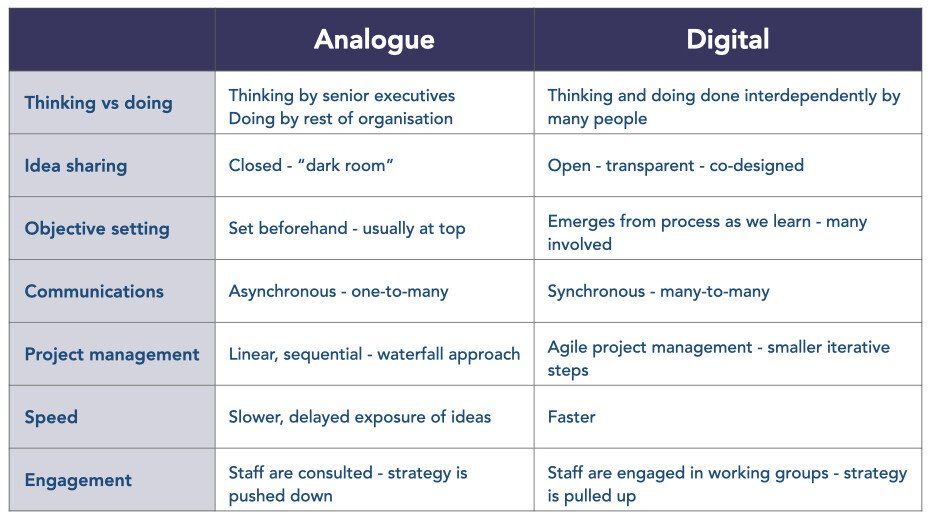You can improve your strategy by shifting from an analogue approach to a digital approach. Here I share my insights in leadership and strategy in this disruptive world we live in.
In a recent article I discussed how all significant initiatives in your business begin with a well thought-out, clear strategy — whether it’s change management, implementation of an Agile process, or the development of an innovation program.
However, there seems to be a lack of confidence in the ability of strategy to deliver results when speed and agility is required.
The Analogue approach vs Digital approach
One of the problems we see, is the way organisations practice strategy — that is separating the formulation from the execution of strategy. This separation is what we term an analogue approach. Instead, we are advocating that a digital approach be adopted.

The analogue approach can be likened to traditional photography, with the use of a dark room to develop your picture. In this situation, we take time to take the perfect picture, and then wait for the photo to be developed. The final picture however cannot be changed once the process is completed.
The digital approach, on the other hand, is where we take the picture, review it immediately, and then keep on clicking until we get a picture that we are satisfied with.
It is the digital approach that we see as being critical for organisations to adopt.
Why a Digital approach?
A digital approach addresses three of the common failings of the traditional analogue strategy. A digital approach will:
- include a much wider set of views in the organisation by integrating the views of people who normally formulate the strategy with those who normally execute the strategy. The understanding of the market is likely to be more complete
- build a strong rationale (the “why”) for the strategy through the organisation right from the beginning of the process
- achieve a higher level of engagement and commitment to the strategy.
What are the key differences between an analogue approach and the digital approach?

How do we achieve the digital approach/methodology to create a clear strategy?
My colleague Lisa Carlin and I have identified 4 processes to achieving a digital approach to a clear strategy:
- An open strategy development process immerses a representative cross-section of people in the organisation, not just the board or senior executives
- A many-to-many, synchronous communication process occurs between those responsible for developing the strategy, and the rest of the organisation. Furthermore, the process is not periodic, it is an ongoing working methodology with staff at different levels — often termed a ‘co-designed’ approach
- A seamless integration between strategy formulation and execution phases takes place through an iterative Agile process. This means that ideas are trialled through small, low-risk pilots — allowing some ideas to occur concurrently with the formulation of other ideas
- Technology platforms offer a number of tools that can speed up this process, many of which can be used in a hybrid working environment. These include tools for engagement, productivity, communication and training.
You may be interested to watch my latest video below...
The 3 Horizons of Strategy - What it Really Means
About Norman
Dr Norman Chorn is a highly experienced business strategist helping leaders build highly successful and resilient organisations. Well known to many as the ‘business doctor’! By integrating the principles of neuroscience with strategy and economics Norman achieves innovative approaches to achieve peak performance within organisations.
Subscribe to our regular articles, insights and thought leadership




